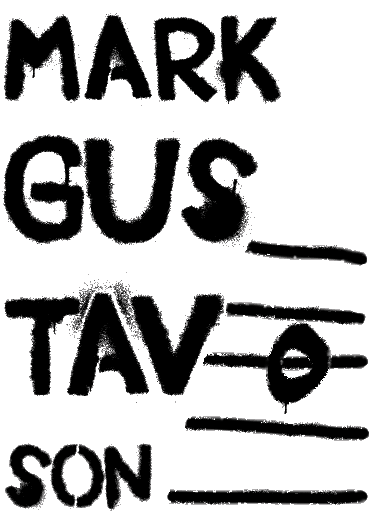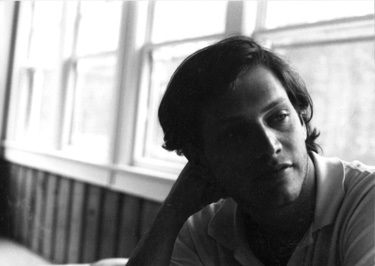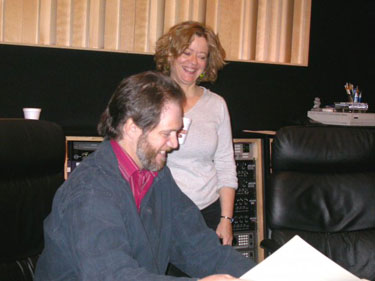
MARK GUSTAVSON RETROSPECTIVE:
CHAMBER MUSIC FROM 1986-2000

| Dissolving Images (15:51), Lisa Moore, piano Quintet (26:40), Contempo (Ed Gilmore, clarinet, Sharon Polifrone & Theresa Fream, violins, Keith Conant, viola, Kim Scholes, ’cello ) A Fool’s Journey (14:50), Parnassus, Anthony Korf, conductor Trickster (9:59), Mark Gustavson, clarinet Jag (10:26), Speculum Musicae, Allen Blustine, conductor
|

Photo credit: Pamela Gurman
was composed in 1986. The structure and quality of this solo piano piece is loosely based on the poem “Thinking, Tangling Shadows” by Pablo Neruda from ”Twenty Love Poems and a Song of Despair”, translated by W. S. Merwin:
Thinking, tangling shadows in the deep solitude.
You are far away too, oh farther than anyone.
Thinking, freeing birds, dissolving images,
burying lamps.
Belfry of fogs, how far away, up there!
Stifling laments, milling shadowy hopes,
taciturn miller,
night falls on you face downward, far from the city.
Your presence is foreign, as strange to me as a thing.
I think, I explore great tracts of my life before you.
My life before anyone, my harsh life.
The shout facing the sea, among the rocks,
running free, mad, in the sea-spray.
The sad rage, the shout, the solitude of the sea.
Headlong, violent, stretched towards the sky.
You, woman, what were you there, what ray, what vane
of that immense fan? You were as far as you are now.
Fire in the forest! Burn in blue crosses.
Burn, burn, flame up, sparkle in trees of light.
It collapses, crackling. Fire. Fire.
And my soul dances, seared with curls of fire.
Who calls? What silence peopled with echoes?
Hour of nostalgia, hour of happiness, hour of solitude.
Hour that is mine from among them all!
Megaphone in which the wind passes singing.
Such a passion of weeping tied to my body.
Shaking of all the roots,
attack of all the waves!
My soul wandered, happy, sad, unending.
Thinking, burying lamps in the deep solitude.
Who are you, who are you?
Quintet
for clarinet, two violins, viola and ’cello was commissioned by the Fromm Foundation in 1993 and premiered on the final Paul Fromm Concert at the University of Chicago.
Quintet was the maturing of a number of ideas that had appeared in previous works. The idea for the piece was to explore a different aspects of rhythm in each of the four movements: I. acceleration; II. motion; III. texture; and IV. ornamentation and drone.
The first movement is a harmonic expansion of the opening eight measures. The very slow-moving initial material gradually accelerates and expands throughout the movement. With each expansion, ornamentation and embellishment increases. The manner in which the expansions occur is not linear and the material within the expansions do not expand at the same rate.
A double variation is the basis of this brief second movement. Each variation explores motion through combinations of layers of different meters and tempi that simultaneously occur to produce the illusion that either the layers are moving at different rates or the pulse is erratic.
In the third movement the independent clarinet plays a cycle of motives that is accompanied by a canon (whose subject consists of continuous eigth-notes) in the strings. The use of a single rhythmic value (the eighth-note) allows the rhythm to dissolve through repetition and create a texture that allows one to hear the harmonic qualities of the many intervallic combinations created by the continuously rising and falling string lines.
The ’cello part in the fourth movement is influenced by the dombek, a Middle eastern drum. This instrument produces two basic sounds: a low resonant thump produced by striking the head of the membrane with a cupped hand and a higher, brighter sound when sharply rapping the edge of the drum head with the fingers. The ’cello part is not a re-creation of dombeck playing but a trace of its sound and role as a drone to support a solo instrument. The clarinet writing, too, is influenced by Middle eastern zummara’s (the clarinet’s ancient ancestor) ornamented playing and is composed to sound loose and improvised. The movement is comprised of varying types of drones that overlap to create a texture that the clarinet can intertwine its gradually embellishing line.
A Fool’s Journey
was commissioned by the New York-based ensemble Parnassus who premiered the work in 1999 under their director Anthony Korf. The piece is in two movement. The first movement marked 0. represents the Fool a blithe figure who is unaware of his surroundings and just laughs off fear. The sleigh-bells refer to the bells the Fool often is depicted wearing in Tarot cards and the piano figures suggest the yapping dog who follows the Fool and warns him of
imminent danger.
The second movement, or Part II is the Fool’s encounter with the Magician who introduces the Fool to intellect and technique. This movement is a series of treatments or loose expanding variations based on the opening piccolo figure and piano figure though treated separately. These variations further explores the musical sounds of laughter from smug giggles to raucous guffaws.
Trickster
was my response to the death of a friend who succumbed to meningitis as a result of AIDS in 1997. I had always thought of him as an archetypical Trickster, a clever and mischievous fellow who always survived dangers and challenges. With the Trickster myth in mind I composed a solo clarinet piece using expanding variations based on the opening phrase. The resurrection quality associated with the Trickster archetype is realized with each new entrance of the opening upward arpeggio that marks the beginning of a
new variation.
Without ever quoting it but by hinting at it one can hear the trace of Strauss’ “Till Eulenspiegel’s Merry Pranks” famous Eb clarinet solo passages in various figures throughout. Trickster is also self-referential in regards to the tricky figures required of the player, especially the long sequence of tremolos that end the piece in a whisper.
Jag
is a work from 1990 and was premiered in 1996 on a Sonic Boom! Festival concert by Speculum Musicae, Allen Blustine conductor. As with the other works listed here, an important musical element and treated as a motive is the opening interval. For Jag that interval is the major sixth (Dissolving Images: minor third, Quintet: perfect fifth, Trickster: tritone and A Fool’s Journey: major second).